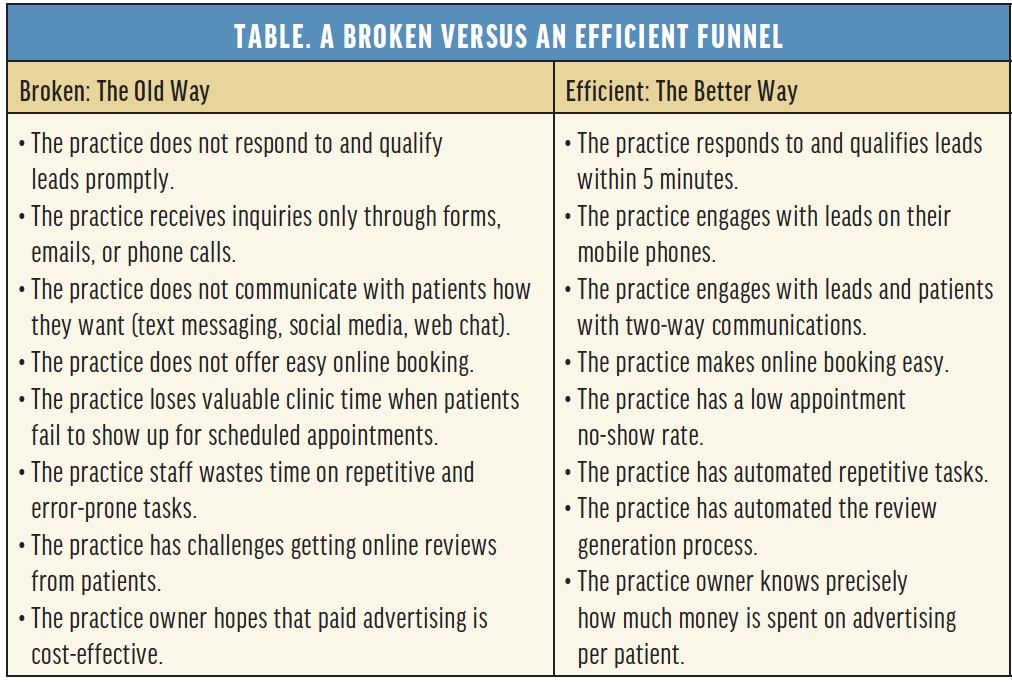

Like most marketers, we get excited about traffic and leads. They are how we win in the marketing field. In health care marketing, however, our clients (cataract and refractive surgeons) win with appointments and patients. A dichotomy between the goals of the marketing agency and those of the surgeon can lead to dissatisfaction and frustration on both sides.
DIVERGENT GOALS
Confronted by a dissatisfied surgeon, many marketers would say, “I got you the traffic and the leads. If you can’t convert them, that’s your problem.” Many surgeons would respond, “I don’t care how much traffic my website gets, and leads are useless to me if they don’t become patients!”
Frustrated eye surgeons move from agency to agency without getting what they want, and marketing agencies become frustrated with surgeons who do not seem to value their efforts. Neither party is at fault. The problem is a misalignment of objectives—the surgeon and the agency never agreed on what winning looks like.
THE MARKETING PERSPECTIVE
Marketers can spend a lot of time and energy trying to change people’s minds. Changing minds is difficult. It is much easier to change the audience or the offer.
Changing the audience. Changing the audience means spending more time with someone else. Many marketers enter the health care space expecting a clientele with deep pockets but soon realize that marketing for surgical services is typically underfunded, overly restrictive, and underappreciated by surgeon clients. Surgeons, moreover, do not spend time developing their practices like other businesspeople. Surgeons are often too focused on working in their practice to focus on working on their practice (click here to read a related article). This makes it harder for marketers to initiate projects, obtain feedback, and implement solutions. Many marketers look for customers outside of health care as a result.
Changing the offer. Some marketers change the offer when faced with challenges. This is the road we chose when we realized that most surgeons do not want to understand marketing but simply want results in the form of more appointments and patients. Shared goals are crucial for marketing agencies and eye surgeons to cooperate effectively.
A BROKEN FUNNEL
Characteristics. When surgeons offer their services, they are simultaneously creating a marketing and sales funnel. Rather than effortlessly move patients through the journey, most of the time, the funnel is full of leaks and bottlenecks that prevent leads from becoming patients. This is understandable. Why would surgeons be expected to know how to create an effective sales and marketing funnel?
The Table below shows some traits of a broken marketing and sales funnel on the left and an efficient marketing and sales funnel on the right (ie, the old and better ways, respectively). Nearly every practice we have encountered in the past 20 years has had the profile on the left, probably because they did not adopt new technology quickly enough and their marketing agencies focused mainly on pouring traffic and leads into a broken funnel.

How to fix it. We recommend taking the following steps to bring the objectives of a practice and a marketing agency into alignment.
No. 1. Tell the agency how many patients you want.
No. 2. Agree on a budget. This is the amount the agency can spend to deliver the targeted number of patients.
No. 3. Monitor the funnel to determine whether it begins to exhibit more characteristics of the better way. Traffic and leads are nice, but appointments and patients pay the bills.
No. 4. Agree on the fee you’ll pay your agency to aim to achieve the mutually agreed upon objective in a reasonable time.
No. 5. Let the agency do its work.
No. 6. Evaluate the agency’s performance against objectives every 90 days.




